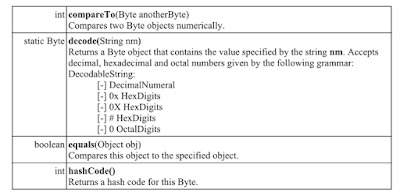In the most general sense, you create a thread by instantiating an
object of type Thread. Java identifies two ways in which this can be
accomplished:
(i) You can implement the Runnable interface.
(ii) You can extend the Thread class, itself.
1. Implementing Runnable
The
easiest way to create a thread is to create a class that implements the
Runnable interface. To implement Runnable, a class need only implement a
single method called run():
public void run()
Inside the run() method, you will define the code that constitutes the new thread.
The run() can call other methods, use other classes and declare
variables, just like the main thread.
The only difference is that run()
establishes the entry point for another, concurrent thread of execution
within your program. This thread will end when run() returns.
After
you create a class that implements Runnable, you will instantiate an
object of type Thread from within that class using one of the following
constructors:
Thread(Runnable threadObj)
Thread(Runnable threadObj, String threadName)
Here threadObj is the object whose run method is called and threadName is the name of the new thread.
After
the new thread is created, it will not start running until you call
start() method. The start() method puts the thread in the ready queue
(runnable state). Whenever the thread gets scheduled its execution will
start from the run() method.
Example:
class X implements Runnable
{
public void run()
{
for(int i=1; i<=5; i++)
{
System.out.println("Child Thread: " + I);
}
System.out.println("Exiting child thread");
}
}
class RunnableTest
{
public static void main(String args[])
{
X runnable = new X();
Thread ct = new Thread(runnable);
ct.start();
System.out.println("main thread exiting");
}
}
Output:
main thread exiting
Child Thread: 1
Child Thread: 2
Child Thread: 3
Child Thread: 4
Child Thread: 5
Exiting child thread
Example:
class NewThread implements Runnable
{
Thread t;
NewThread()
{
t = new Thread(this, "Demo Thread");
System.out.println("Child thread: " + t);
t.start();
}
public void run()
{
for(int i=5; i>0; i--)
{
try
{
System.out.println("Child Thread: " + I);
}
catch(InterruptedException e)
{
System.out.println(e);
}
}
System.out.println("Exiting child thread”);
Thread.sleep(500);
}
}
class ThreadDemo
{
public static void main(String args[])
{
new NewThread();
try
{
for(int n=5; n>0; n--)
{
System.out.println("Main Thread: " + n);
Thread.sleep(1000);
}
}
catch(InterruptedException e)
{
System.out.println("main thread interrupted");
}
System.out.println("main thread exiting");
}
}
Output:
Child thread: Thread[Demo Thread,5,main]
Main Thread: 5
Child Thread: 5
Child Thread: 4
Main Thread: 4
Child Thread: 3
Child Thread: 2
Main Thread: 3
Child Thread: 1
Exiting child thread
Main Thread: 2
Main Thread: 1
main thread exiting
2. Extending Thread class
The
second way to create a thread is to create a new class that extends
Thread and then create an instance of that class. The extending
class must override the run() method, which is the entry point for the
new thread. It must also call start() to begin the execution of the new
thread.
Example:
public class NewThread extends Thread
{
NewThread()
{
super("Demo Thread");
System.out.println("Child thread: " + this);
start();
}
public void run()
{
for(int i=5; i>0; i--)
{
try
{
System.out.println("Child Thread: " + I);
sleep(500);
}
catch(InterruptedException e)
{
}
}
System.out.println("Exiting child thread");
System.out.println(e);
}
}
class ExtendThread
{
public static void main(String args[])
{
new NewThread();
try
{
for(int n=5; n>0; n--)
{
System.out.println("Main Thread: " + n);
Thread.sleep(1000);
}
}
catch(InterruptedException e)
{
System.out.println("main thread interrupted");
}
System.out.println("main thread exiting");
}
}
Output:
Child thread: Thread[Demo Thread,5,main]
Main Thread: 5
Child Thread: 5
Child Thread: 4
Main Thread: 4
Child Thread: 3
Child Thread: 2
Main Thread: 3
Child Thread: 1
Exiting child thread
Main Thread: 2
Main Thread: 1
main thread exiting
Note: If the thread is not assigned any name, it will be something like Thread-1, Thread-2, Thread-3 etc.
3. Choosing an Approach
The thread class defines several methods that can be overridden by a derived class. Out of these methods, the only one that must be overridden is run().
That is, of course, the same method required when you implement the Runnable interface. Many Java programmers feel that classes should be extended only when they are being enhanced or modified in some way.
So, if you will not be overriding any of Thread’s other methods, it is probably best simply to implement a Runnable interface.

















